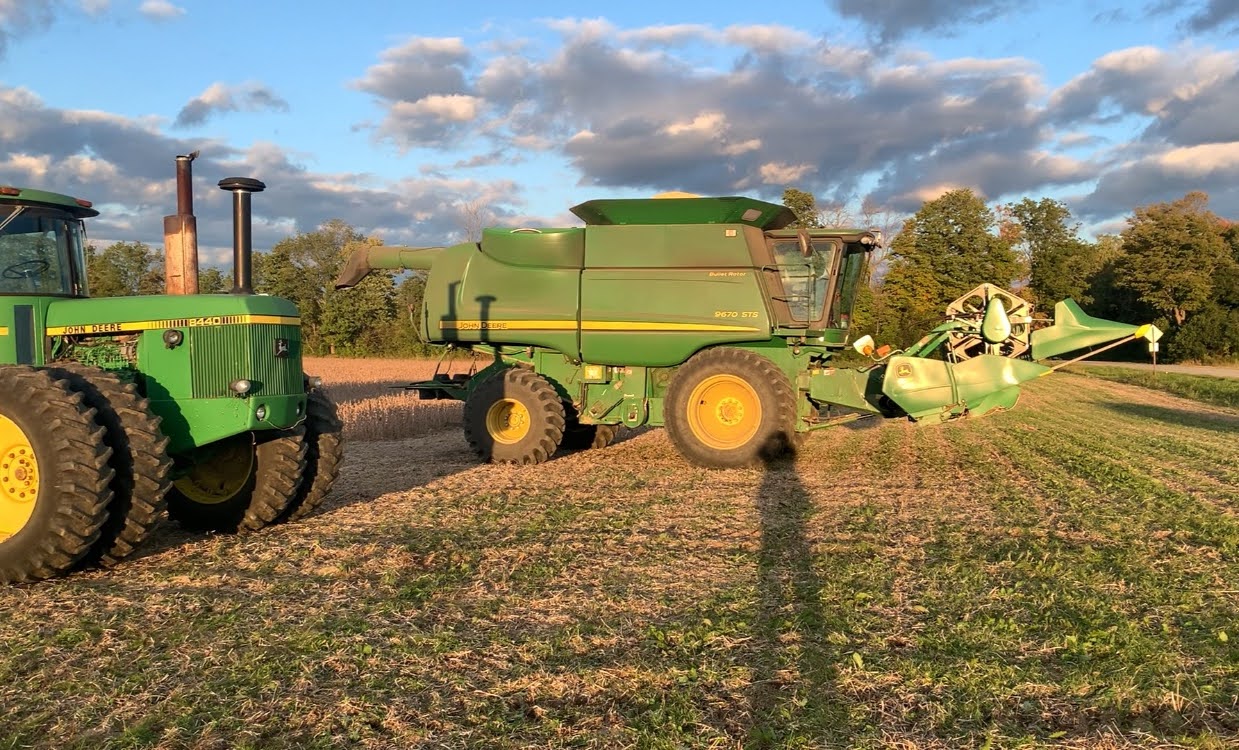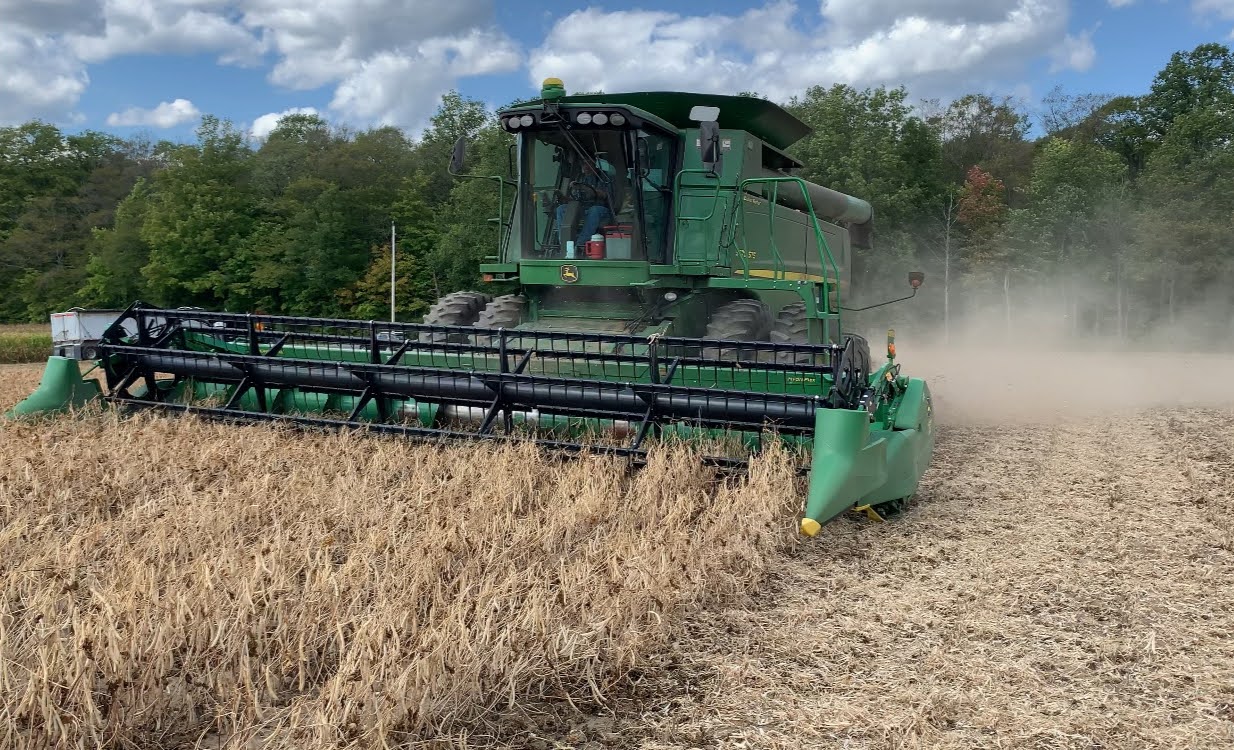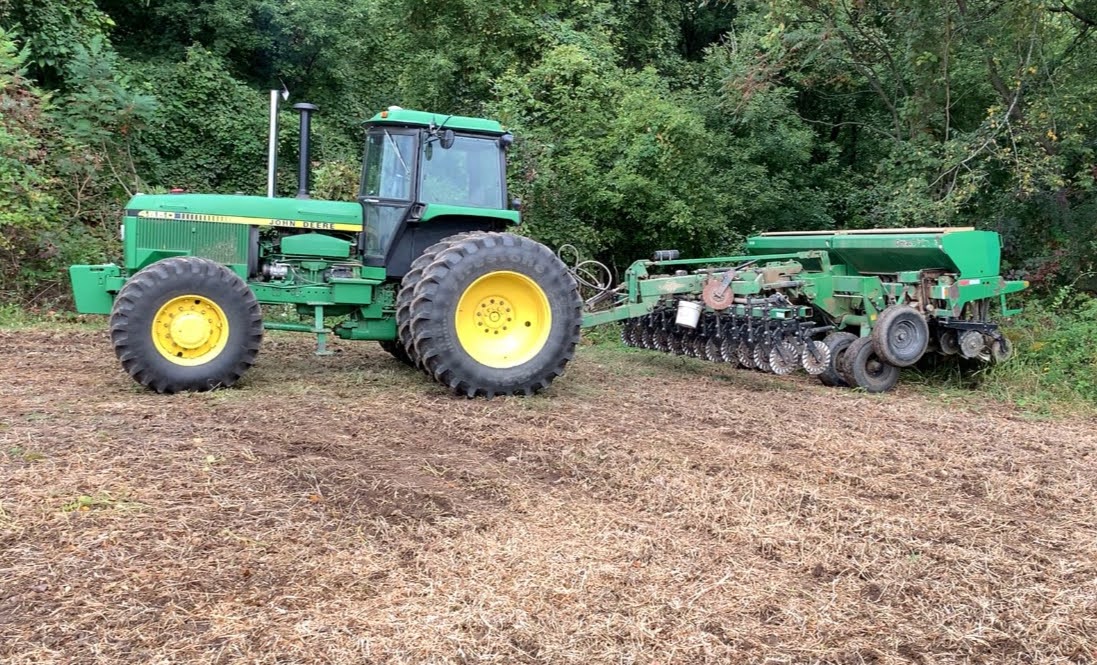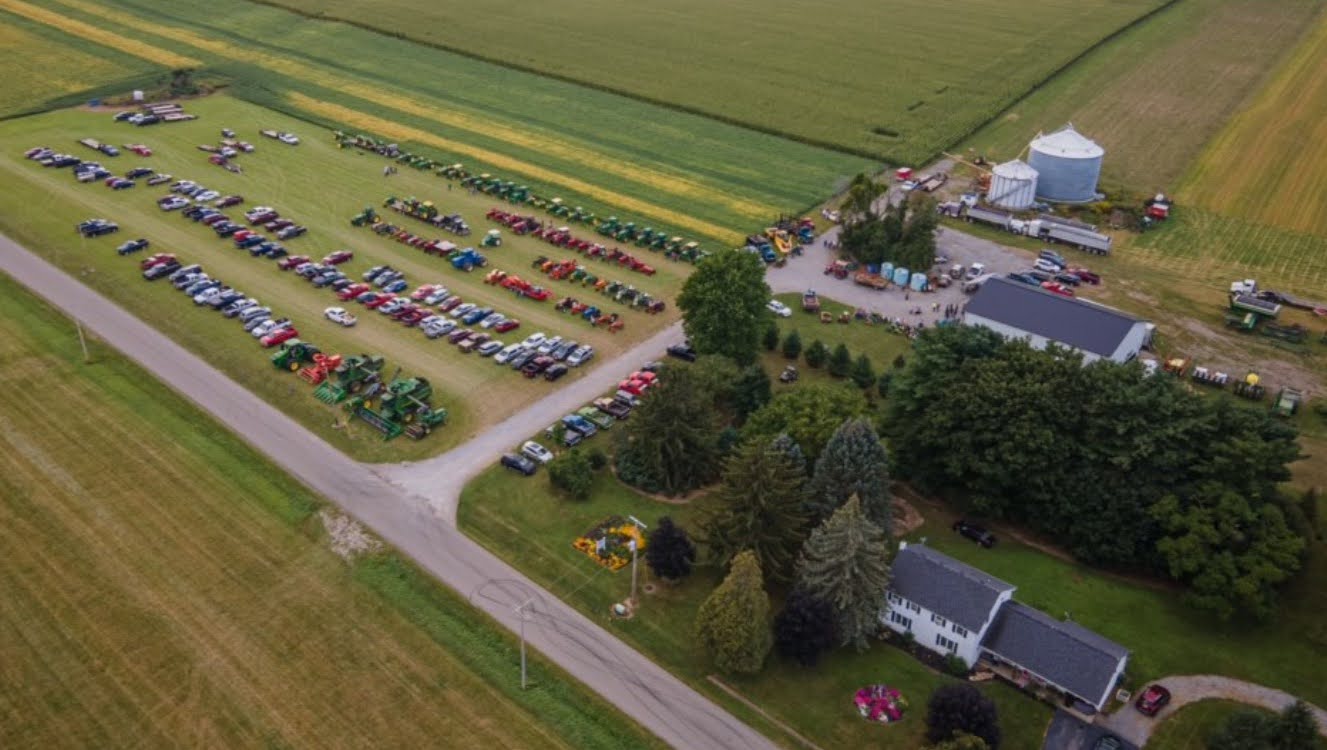Sumbi#@% Farmer Shatters Convention, Earns Big Seat at Agriculture’s Table
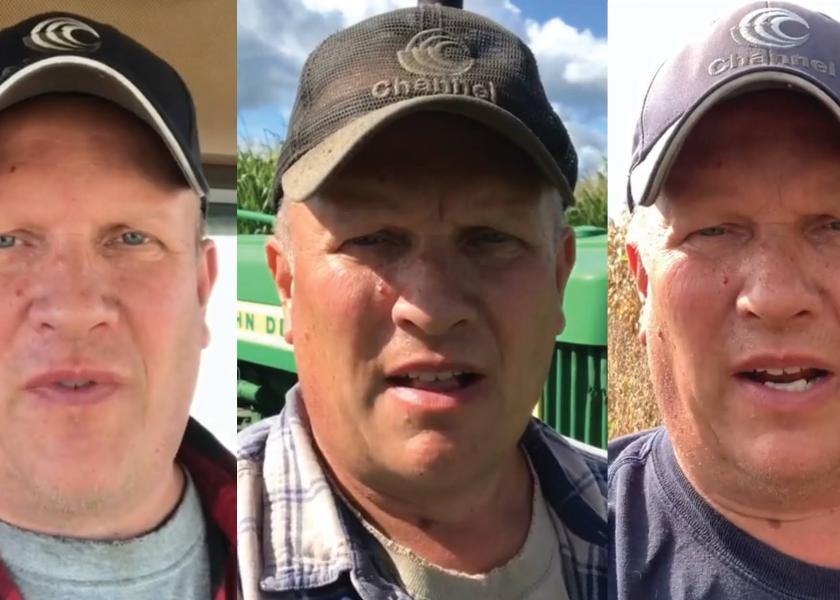
The sumbi#@% farmer starts every day with a can of Pepsi at breakfast, chased by another at lunchtime, and, if the wife’s not looking, a final can washed down with supper. Tossing convention from the tractor cab and backing over it, the sumbi#@% farmer has turned formulaic agriculture on its head. Meet Tom Corcoran, the self-titled sumbi#@% and a man possessed by the will to succeed.
In 2010, at 41, after 20-plus years as an employee, Corcoran chose to cut bait and farm on his own. No land; no equipment; no shop. A decade later, he grows crops on 1,000-plus acres, and maintains a bustling sidecar of farm-related businesses. Once a banker’s nightmare, the affable Corcoran has earned a deserved and highly respected seat at agriculture’s table. “Anyone can do what I’ve done,” he says, “but how far are you willing to go? Sitting at home after 40 hours won’t cut it; there’s still 128 hours left in the week. What are you prepared to do?”
The Hopeful Outsider
In western New York’s dairy country, roughly 60 miles directly east of Buffalo and Lake Erie, Corcoran, 51, farms alongside his wife, Diane, and son, Troy. The Corcoran trio grows dryland black beans, corn, soybeans, and winter wheat in Livingston County loam, outside the small town of Caledonia, on picturesque 20- and 40-acre fields broken by hills and woods. They also custom combine, custom strip till, haul salt, and sell seed—all part of an effort to ensure side-stream income.
“We hustle and we’re blessed to do so,” Corcoran says. “In our case, we can’t just plant corn and soybeans, harvest in the fall, and make a living. Trucking, combining, seed and other things are all part of how we have to operate. I’ve seen guys fail, at least in my area, because they didn’t want to do anything else in the offseason.”
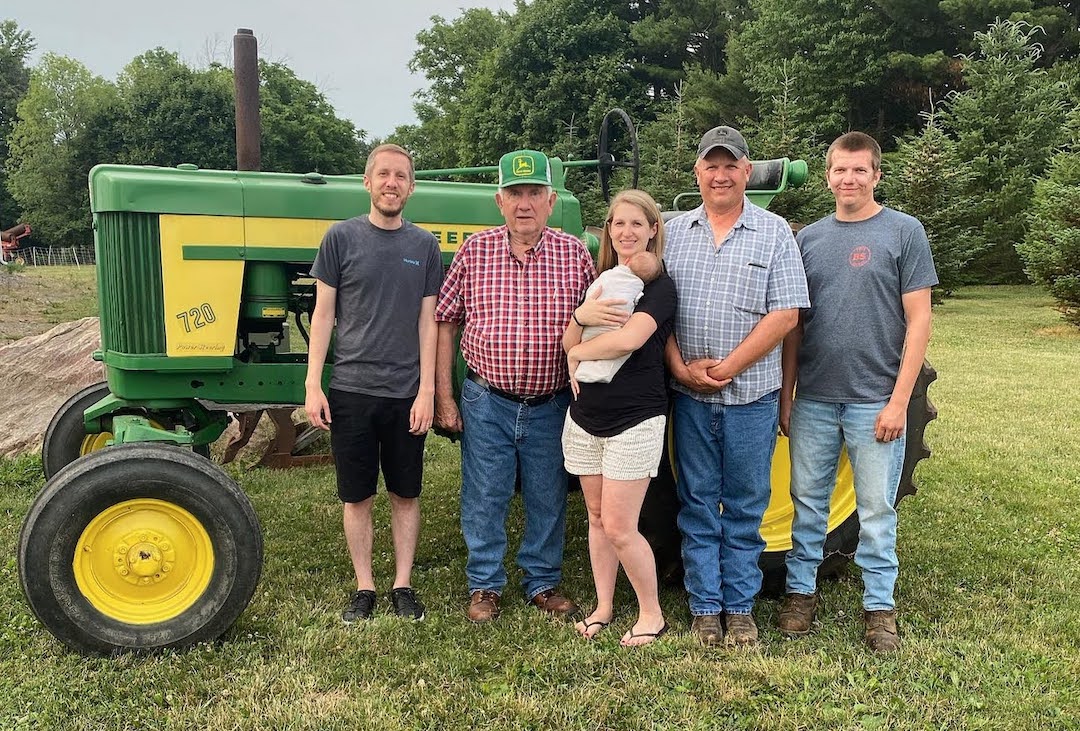
All things equal, if Corcoran had been told 15 years in the past that by 2021, he’d be on 1,000 acres, owner of several grain bins and a heated shop, partner with a mechanical-genius son, entrepreneur of multiple business ventures, Instagram personality with 8,000 followers, and the conductor of an annual tractor show to benefit Alzheimer’s research, he likely would have balked at the proposition.
Yet, how does a farmer go from hopeful outsider to operation owner in a single decade?
“Again, it’s cliché, but determination was a huge factor,” he says, “but breaking it down in real plain terms, maybe I wasn’t smart enough to realize I could fail. I always knew I’d have my own farm.”
Sincerely. Rewind to the 1970s.
No Tools? No Problem
At the beginning of a turbulent decade for U.S. agriculture, Corcoran was born in 1970, and grew up in a salt-of-the-earth family with a 50-cow dairy farm. At 18 years young, he stepped off the small plot of home ground, and waded into the realities of hired labor on bigger agriculture operations in Livingston County. “Right away I knew I was not going to be an employee for life,” he says. “I intended to farm on my own.”
However, life rarely moves in straight lines, and as the years began to stack, the normal cycle of marriage, children, finances, and rabbit trails demanded adherence to delayed gratification. Year after year, Corcoran patiently pocketed one growing lesson after another as a hired man, while gaining a toehold on the future through custom cutting and the purchase of a handful of acres.
A decade passed—and then another.
It was 2009, and Corcoran stood at a proverbial fork-in-the-road. “I knew it was now or never. Maybe it was my version of a biological clock going off, but something clicked. We didn’t have any money, but I knew it was go-time, and I started putting the pieces in place—equipment and land to rent.”
On a telltale night in 2009, with Diane covering hours as waitress, Corcoran chanced upon a farm widow selling several pieces of used equipment, and he dropped $25,000 on the deal—although the family checking account only contained a lean $500. Finishing her evening shift, Diane called Corcoran on the way home from work, only to hear details of the machinery purchase. “I broke the news to her, but she was already all in.”
Diane and Corcoran are two sides of the same coin. Growing up, her father drove a cement truck for 35 years, started a dairy farm as a secondary job, and made sure Diane fed cows before school and worked herd chores after getting home. The model of toil and ancillary income was seeded in her blood, and Diane backed Corcoran to the hilt. “She was willing to do whatever it took,” Corcoran says. “Diane gave me her approval and blessing, and I’ve always felt like I could do anything as long as she believed in me.”
With no significant equity, cash flow, or track record, Corcoran called a banker friend and found a lifeline. “Yes, the banker was nervous, but he supported me and gave me a chance.”
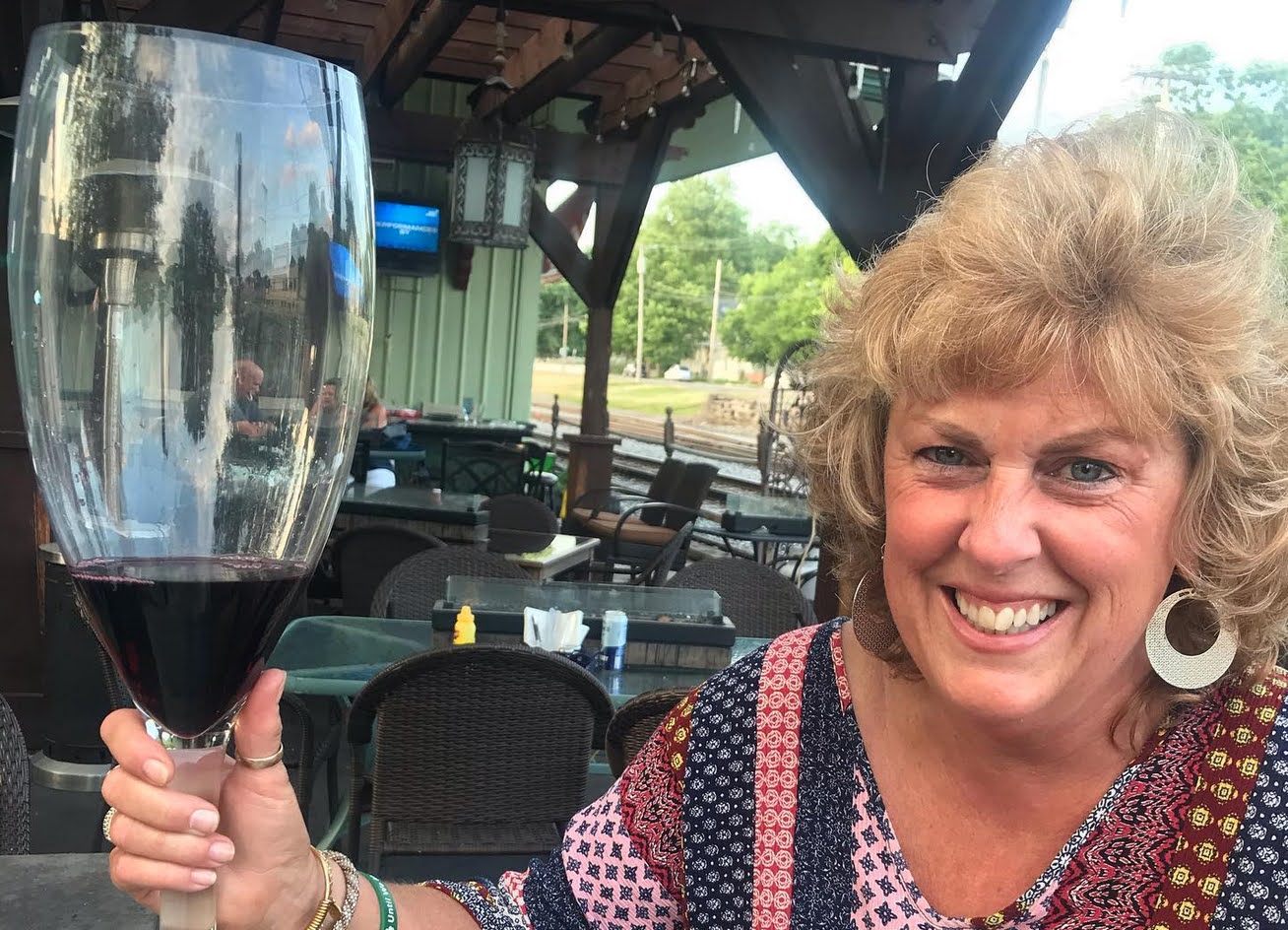
In 2010, with no shop or headquarters (working out of his house garage), Corcoran planted corn and soybeans on 140 acres of rented land 24 miles from home. “I had people that thought I was crazy and that I’d fail. That is always part of the picture in farming, and I didn’t waste time on that because there were so many others that encouraged me. I gravitated toward them.”
Along with finding budget-priced equipment, Corcoran faced a challenge often overlooked when starting from scratch: the need for an arsenal of endless shop-related items. In small bites, he bought tools, toolboxes, workbench, vise, welding gear, chains, and far more odds and ends—a seemingly infinite list of work-related necessities not often considered in a budget. “Think about all the small items on a farm and shop,” he says. “That’s what we had to buy. Amazing amount. When you start with almost nothing, then that means a lot of trips to the tool store. We didn’t even have tools for the tractor boxes.”
In 2011, while Diane waitressed, Corcoran added a few more acres, built a pole barn to serve as a shop, and burned extra time on side hustles—anything to add pennies to the pot. In 2012, he kicked up heresy during custom harvest by direct cutting dry beans. In his geography of western New York, pulling dry beans was gospel—cut at the roots, dropped in windrows, and harvested with a pull-type combine.
Direct cutting dry beans was common in the West, and Corcoran followed suit. No more extra steps or additional equipment. The difference was money. “People thought we were crazy. They said, ‘It can’t be done here.’ Why not? I don’t believe you leave any yield behind, and the labor, time, and fuel savings are huge. You can do more in more day, with just one person, than you can do in a week the other way.”
Other growers rapidly began to copy Corcoran’s technique. Maybe, the “crazy” new guy was not so crazy. Maybe he was a leader.
Skin in the Game
Keep it in the family. In 2016, the Corcoran operation got a major boost when Troy graduated from diesel college, and returned with motor rebuilds, transmission repairs, and litany of other fixes. Troy, with abundant mechanical skills, ensured the machinery fleet, related to row crops and side businesses, functioned at a top level.
“Troy was the key to getting best value from our equipment,” Corcoran notes. “Everything we have is older stuff, and that means all our money then, and now, went into land and drain tile. We pride ourselves on modest equipment (even today, the newest tractor on the operation is from the 1980s), and we don’t want to spend money on shiny paint that sits for 11 months of the year.”
At roughly 100 acres per year, leasing and purchasing small fields, the operation continued to grow, boosted by Corcoran’s reputation as a tenant with integrity. “We have fantastic landlords,” he emphasizes. “They see how we treat the land with strip till and covers, and they’re not afraid to give us a shot.”
Beyond corn and soybeans, Corcoran relies on side employment as an income booster. Farm first; side-stream income next. “Don’t chase dimes while you trip over dollars at home,” he says, “but in our case, corn and soybeans by themselves aren’t enough to make a living. That means cutting dry beans, custom strip tilling, trucking salt, and selling seed.”
Seed, indeed. In 2015, Corcoran was approached by Bob Pawlowski, a friend, farmer, and Channel Seed salesman in Oneida County, two hours east in the Mohawk Valley. Pawlowski, with 1,600 acres of corn, grain sorghum, hay, soybeans, and wheat, cut his own path to a farming career—in the same vein as Corcoran.
“Tom is and was hungry,” Pawlowski describes. “He’s aggressive in growing a crop and looking for opportunity. For example, strip tilling was not common here, but he jumped on it ahead of the curve and made some money.”
“It’s very rare to see a guy start so small and succeed. People respect Tom and want to work with him because he’s a guy that creates opportunities because of his attitude and preparation. When a chance comes you have to be ready.”
Following Pawlowski’s example, Corcoran took a shot at selling seed. “When you are a farmer buying seed from another farmer who already grows those exact varieties, there is a line of trust,” Pawlowski adds. “Why? We both have skin in the game.”
For Corcoran, a natural people-person, Channel Seed was an ideal fit: “Seed is the side business I truly enjoy. I’ve got a great core of customers and the truth is I learn far more from them then they do from me.”
“Seed is one more example of why I’ve been able to make it in farming,” Corcoran continues. “Yes, I’m very determined, but I’m blessed with Diane, Troy, great landlords, great part-time guys, a great lender, great farming friends, and so much encouragement from so many places. It’s not just a cliché; there are some wonderful people in farming that will help you if you work hard.”
Birth of the Sumbi#@%
Western New York, as with most agricultural regions in the U.S., presents growers with a unique, changing series of knots to untie each season, a situation Corcoran views as an opportunity expressed best on the back of his Peterbilt: “It says, ‘Make it Happen,’ and that’s what I believe. I throw cliché phrases around all the time—because I believe every word.”
Along with corn, dry beans, soybeans, and wheat, Corcoran’s ground grows stones, or so it seems. Every spring, he strip tills prior to planting, and then rolls back across with a rock picker to grab exposed stones—often the size of basketballs or sometimes significantly larger. Diane follows with a 35’ cultipacker, manually grabbing anything left behind by the rock pickers.
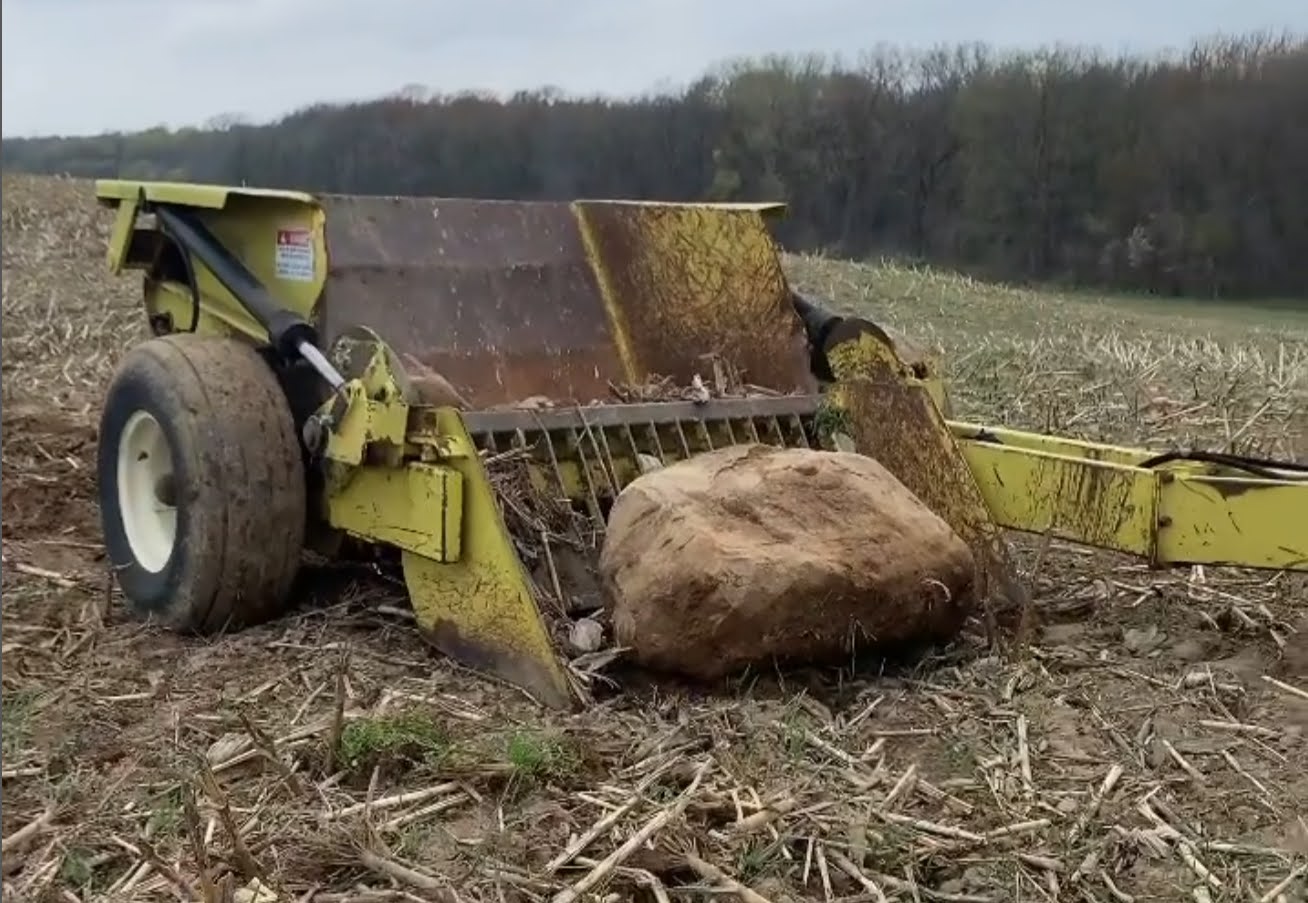
Beyond occasional equipment damage from rocks, a far more chronic concern is a relatively short growing season. Corcoran’s geography gets 39” of annual precipitation, but the number is highly misleading. Included in that total is a numbing 90” of snowfall each year. A frost into the first two weeks of May is a strong possibility, bookended by frost again by Oct. 1, making corn beyond 100 days a risky business. (Corcoran averages 97-day corn.) The first big snow often arrives in late October and can create a logistical minefield at harvest. Snow through a combine is major trouble, unless the temperatures are brutally cold—low enough to ensure snow particles are crystallized and blow through the combine, avoiding the mess of melt. (Typically, his corn is cut at 18-25% moisture and run through a dryer.) “We’ve had to combine soybeans in January because of too much snow and cut corn for friends at Christmas. That’s farming sometimes in our area.”
Prior to harvest in 2018, after hosting a Channel Seed field day, Corcoran was left with a surplus of food. He invited 12 friends with 12 old tractors to a farm party, and charged $5 per head, in order to make a donation for Alzheimer’s research. (In 2016, Diane’s father, Warren Hunt, Sr., passed away due to Alzheimer’s.) Word filtered to more farms, and the gathering drew 70 people—and they dropped $3,000 in the hat. A tractor show was born.
Recognizing a unique means to raise research funds, Corcoran played with titles, searching for a unique tag for the tractor show, and settled on “Some Unique Machines Brought In To Commemorate History.” Or, stated more bluntly as an acronym: SUMBITCH.
And thus, the sumbi#@% farmer was born.
Presently, the show pulls in hundreds of guests who either haul in antique tractors on trailers or directly drive the antique vehicles to Corcoran’s property on the day of the show. The increasing popularity is raising collection goals—$10,000.
On a whim, stepping far beyond his comfort zone, Corcoran began posting his farming triumphs and trials on Instagram, also in 2018. The sumbi#@% moniker became a figurative tattoo: “As a joke, I named myself sumbi#@% farmer (farming_sumbit#@%) intending to switch to Tom Corcoran. Oh no, I started getting followers and it was on. It was on.”
To his surprise, the response was overwhelming. Over 8,000 followers in short time. Diane followed suit, adopting the title—mrsfarming_sumbi#@%. “Social media has truly helped us as farmers,” Corcoran says. “We’ve got a community beyond our town, and we need to see when other farmers in other places succeed and struggle because that is like a mirror of our lives. One state has guys in drought; another has guys in flood; another has guys in crop disease. I’ve never met most of these people in person, but they are my support network. They understand.”
The Price of Admission
In 2015, John (J.D.) Doemling knew Corcoran was on track to farming success. “I told Tom he’d be at 1,000 acres in five more years,” says Doemling, who has spent a lifetime in agriculture and was Corcoran’s righthand farm help for a decade. “It became a true statement because I saw how hard he worked and I saw his attitude that nothing would bother him as he made one step at a time.”
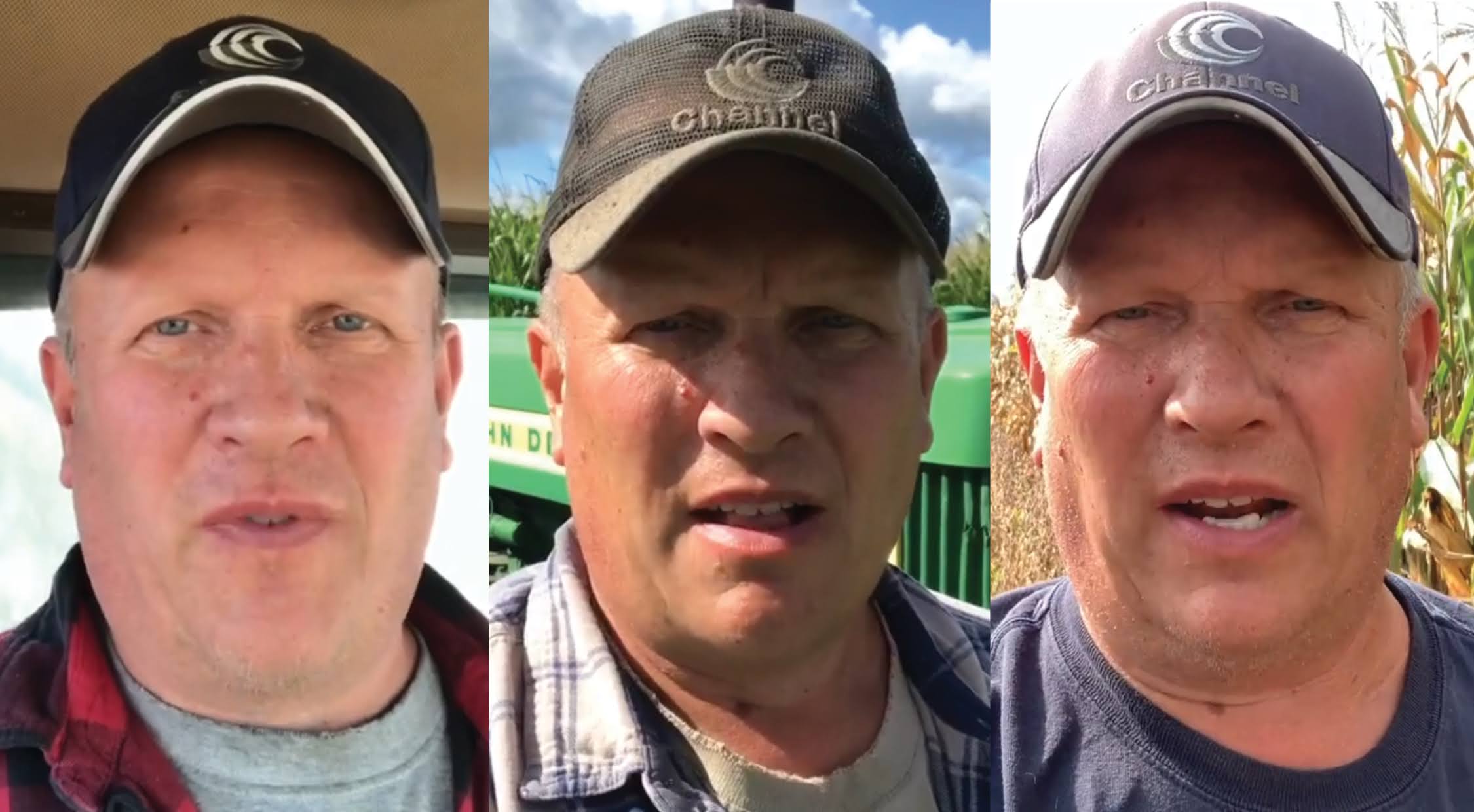
“When Tom talks those clichés like ‘feed the world,’ he means it,” Doemling continues. “Simple, highly intelligent, humble, and caring—that’s Tom. I’ve seen him take off his shirt for another man in so many ways and that is his reputation. All he wanted was to be a successful farmer. It happened.”
At the end of each day, clichés in hand, Corcoran is simply a farmer grateful for his opportunity and lot, willing to put a shoulder to the door of whatever task is required to ensure the success of his family and farm. “If I’d have listened to convention 10 years ago, I’d never have farmed on my own and I’d still be standing on the outside, looking in,” Corcoran says. “I guess everybody has to ask themselves a question: “What are you willing to do? That’s the price of admission to farming.”
Well-spoken by the sumb#@% farmer.
To read more stories from Chris Bennett (cbennett@farmjournal.com), see:
Tractorcade: How an Epic Convoy and Legendary Farmer Army Shook Washington, D.C.
Bagging the Tomato King: The Insane Hunt for Agriculture’s Wildest Con Man
How a Texas Farmer Killed Agriculture’s Debt Dragon
While America Slept, China Stole the Farm
Bizarre Mystery of Mummified Coon Dog Solved After 40 Years
The Arrowhead whisperer: Stunning Indian Artifact Collection Found on Farmland
Where's the Beef: Con Artist Turns Texas Cattle Industry Into $100M Playground
Fleecing the Farm: How a Fake Crop Fueled a Bizarre $25 Million Ag Scam
Skeleton In the Walls: Mysterious Arkansas Farmhouse Hides Civil War History
US Farming Loses the King of Combines
Ghost in the House: A Forgotten American Farming Tragedy
Rat Hunting with the Dogs of War, Farming's Greatest Show on Legs
Misfit Tractors a Money Saver for Arkansas Farmer
Government Cameras Hidden on Private Property? Welcome to Open Fields
Farmland Detective Finds Youngest Civil War Soldier’s Grave?
Descent Into Hell: Farmer Escapes Corn Tomb Death
Evil Grain: The Wild Tale of History’s Biggest Crop Insurance Scam
Grizzly Hell: USDA Worker Survives Epic Bear Attack
Farmer Refuses to Roll, Rips Lid Off IRS Behavior
Killing Hogzilla: Hunting a Monster Wild Pig
Shattered Taboo: Death of a Farm and Resurrection of a Farmer
Frozen Dinosaur: Farmer Finds Huge Alligator Snapping Turtle Under Ice
Breaking Bad: Chasing the Wildest Con Artist in Farming History
In the Blood: Hunting Deer Antlers with a Legendary Shed Whisperer
Corn Maverick: Cracking the Mystery of 60-Inch Rows


